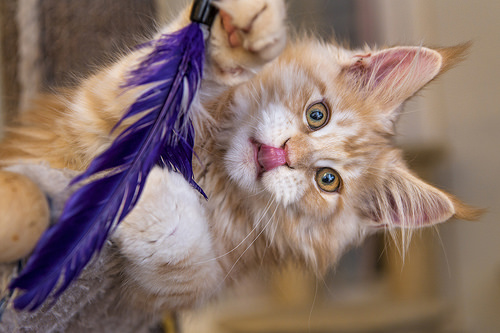You’re thinking of adopting a cat. You’ve done the Meet Your Match® quiz at your local animal centre to find your perfect match and now you’ve got your eye on a special feline you’d like to adopt. Before you bring Fluffy home, make sure you’re ready!
Cats can be mysterious, but knowing how to properly care for one shouldn’t be. Here’s what you need to do to help your cat enjoy a smooth transition into its new life.
Before you adopt – 9 things to know
-

photo credit: Tambako the Jaguar
Orion looking at me and licking his nose while looking at me via
photopin
(license)
Find a nearby veterinary clinic where you can take your cat for routine care and health checks. Note the clinic’s hours and find an emergency clinic for after-hours illnesses or injuries.
- Place a litter box in an easily accessible spot that also offers privacy for your feline friend. If you adopted a kitten less than six months old, use only non-clumping cat litter. Kittens are cute, but they’re also messy. Litter often sticks to their fur and feet. That could lead to digestive and intestinal problems if your kitten ingests any litter while cleaning itself.
- Invest in quality stainless steel or ceramic food and water dishes. Cats need plenty of fresh water daily, so keep your pet’s water dish full of fresh, clean water.
- Good quality cat or kitten food is also a must. Typically kittens should be fed three to four small meals a day. Most adult cats should be fed once or twice daily. Talk to your veterinarian to determine how often and how much to feed your cat.
- Grooming tools, such as a brush or comb, are also important to help keep your cat’s coat healthy.
-

photo credit: hello_hiroki
IMG_3276 via
photopin
(license)
If your cat was writing this list, it would probably ask for toys. If you purchase any toys that contain yarn or string, be sure to supervise your cat at play. Ingestion of these materials can cause serious, and sometimes fatal, intestinal damage.
- A scratching post is a must, as clawing is a natural habit for cats. Choose a scratching post that is tall enough that your cat can fully stretch out when scratching.
- If you plan on letting your cat go outdoors while supervised, get a breakaway collar, identification tag and a harness and leash. It’s important to keep in mind that there are many dangers outdoors for cats. Indoors is a safer option.
- Lastly, fix your pet! Every year, tens of thousands of dogs and cats end up on the streets, where they fall victim to neglect and abuse, or in shelters in search of new homes. Spaying or neutering your pet can help reduce that number. All cats of appropriate age are spayed or neutered at Ontario SPCA animal centres before being adopted. If you didn’t adopt from the Ontario SPCA and your cat is not spayed or neutered, contact your veterinarian for more information.
Owning a cat can be a rewarding experience. We wish you and your new feline friend all the best as you get to know each other!

